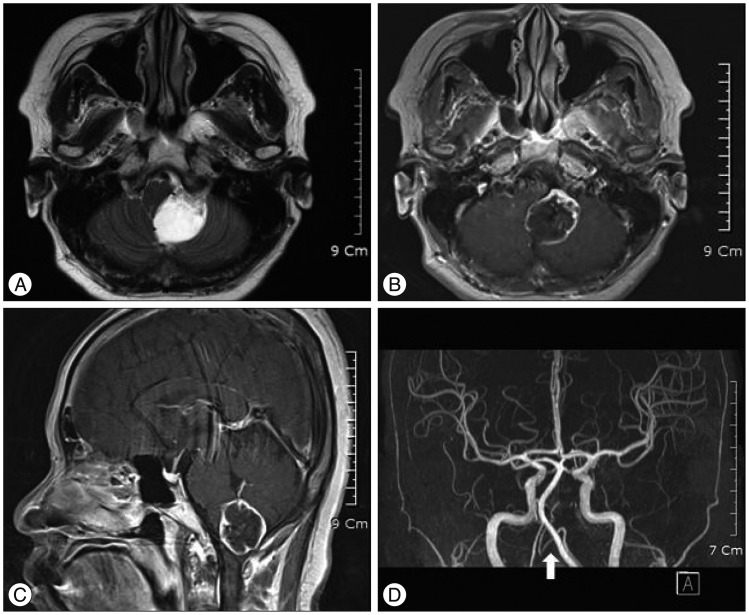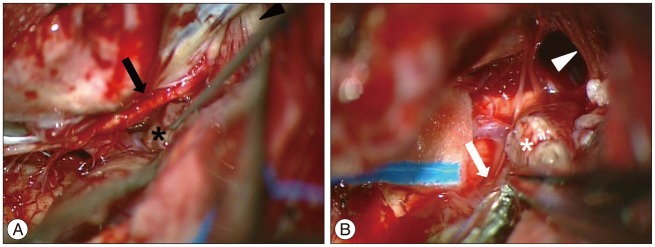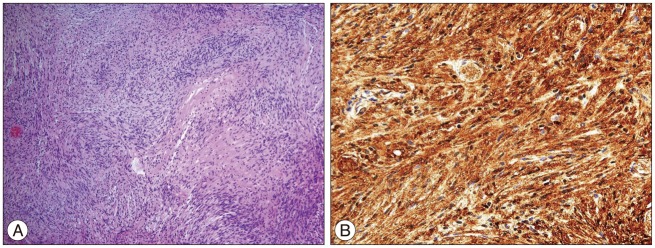J Korean Neurosurg Soc.
2014 Aug;56(2):152-156. 10.3340/jkns.2014.56.2.152.
Intracisternal Cranial Root Accessory Nerve Schwannoma Associated with Recurrent Laryngeal Neuropathy
- Affiliations
-
- 1Department of Neurosurgery, Korea University Medical Center, College of Medicine, Korea University, Seoul, Korea. kyungjae99@hanmail.net
- KMID: 1956520
- DOI: http://doi.org/10.3340/jkns.2014.56.2.152
Abstract
- Intracisternal accessory nerve schwannomas are very rare; only 18 cases have been reported in the literature. In the majority of cases, the tumor origin was the spinal root of the accessory nerve and the tumors usually presented with symptoms and signs of intracranial hypertension, cerebellar ataxia, and myelopathy. Here, we report a unique case of an intracisternal schwannoma arising from the cranial root of the accessory nerve in a 58-year-old woman. The patient presented with the atypical symptom of hoarseness associated with recurrent laryngeal neuropathy which is noted by needle electromyography, and mild hypesthesia on the left side of her body. The tumor was completely removed with sacrifice of the originating nerve rootlet, but no additional neurological deficits. In this report, we describe the anatomical basis for the patient's unusual clinical symptoms and discuss the feasibility and safety of sacrificing the cranial rootlet of the accessory nerve in an effort to achieve total tumor resection. To our knowledge, this is the first case of schwannoma originating from the cranial root of the accessory nerve that has been associated with the symptoms of recurrent laryngeal neuropathy.
MeSH Terms
Figure
Reference
-
1. Bakar B. The jugular foramen schwannomas : review of the large surgical series. J Korean Neurosurg Soc. 2008; 44:285–294. PMID: 19119464.
Article2. Benninger B, McNeil J. Transitional nerve : a new and original classification of a peripheral nerve supported by the nature of the accessory nerve (CN XI). Neurol Res Int. 2010; 2010:476018. PMID: 21318044.3. Bulsara KR, Sameshima T, Friedman AH, Fukushima T. Microsurgical management of 53 jugular foramen schwannomas : lessons learned incorporated into a modified grading system. J Neurosurg. 2008; 109:794–803. PMID: 18976067.
Article4. Caputi F, de Sanctis S, Gazzeri G, Gazzeri R. Neuroma of the spinal accessory nerve disclosed by a subarachnoid hemorrhage : case report. Neurosurgery. 1997; 41:946–950. PMID: 9316059.
Article5. Chang KC, Huang JS, Liu KN, Tsai CS, Chen TY. Neurinoma of the spinal accessory nerve : report of a case. J Formos Med Assoc. 1990; 89:593–597. PMID: 1979603.6. Christoferson LA, Leech RW, Grossman M. Intracranial neurilemoma of the spinal accessory nerve. Surg Neurol. 1982; 18:18–20. PMID: 7112381.
Article7. de Oliveira E, Rhoton AL Jr, Peace D. Microsurgical anatomy of the region of the foramen magnum. Surg Neurol. 1985; 24:293–352. PMID: 4023912.
Article8. DeToledo JC, David NJ. Innervation of the sternocleidomastoid and trapezius muscles by the accessory nucleus. J Neuroophthalmol. 2001; 21:214–216. PMID: 11725190.
Article9. DeToledo JC, Dow R. Sternomastoid function during hemispheric suppression by amytal : insights into the inputs to the spinal accessory nerve nucleus. Mov Disord. 1998; 13:809–812. PMID: 9756150.
Article10. Falla D, Dall'Alba P, Rainoldi A, Merletti R, Jull G. Repeatability of surface EMG variables in the sternocleidomastoid and anterior scalene muscles. Eur J Appl Physiol. 2002; 87:542–549. PMID: 12355194.
Article11. Fink LH, Early CB, Bryan RN. Glossopharyngeal schwannomas. Surg Neurol. 1978; 9:239–245. PMID: 675473.12. Hakuba A, Hashi K, Fujitani K, Ikuno H, Nakamura T, Inoue Y. Jugular foramen neurinomas. Surg Neurol. 1979; 11:83–94. PMID: 424988.13. Julow J. Neurinoma of spinal accessory nerve. Report of two cases. Acta Neurochir (Wien). 1983; 69:219–224. PMID: 6650236.14. Jung TY, Jung S, Kim IY, Kang SS. Intracisternal schwannoma of the spinal accessory nerve : a case report. Skull Base. 2006; 16:175–179. PMID: 17268591.
Article15. Kawaguchi S, Ohnishi H, Yuasa T, Hashimoto H. [Spinal accessory nerve neurinoma in the C2 spinal canal. Case report]. Neurol Med Chir (Tokyo). 1987; 27:1190–1194. PMID: 2452367.16. Kaye AH, Hahn JF, Kinney SE, Hardy RW Jr, Bay JW. Jugular foramen schwannomas. J Neurosurg. 1984; 60:1045–1053. PMID: 6716139.
Article17. Kaynar MY, Hanci M, Sarioğlu AC. Intraspinal schwannoma of the accessory nerve. Br J Neurosurg. 1999; 13:429–431. PMID: 10616577.
Article18. Kurokawa R, Tabuse M, Yoshida K, Kawase T. Spinal accessory schwannoma mimicking a tumor of the fourth ventricle : case report. Neurosurgery. 2004; 54:510–514. discussion 514. PMID: 14744299.
Article19. Lanotte M, Massaro F, Scienza R, Faccani G. Intracisternal schwannoma of the spinal accessory nerve presenting as a normal pressure hydrocephalus syndrome. Case report and review of the literature. Neurosurg Rev. 1994; 17:225–227. PMID: 7838403.
Article20. Leonetti JP, Anderson DE, Marzo SJ, Origitano TC, Shirazi M. Intracranial schwannomas of the lower cranial nerves. Otol Neurotol. 2006; 27:1142–1145. PMID: 17130803.
Article21. Linn J, Moriggl B, Schwarz F, Naidich TP, Schmid UD, Wiesmann M, et al. Cisternal segments of the glossopharyngeal, vagus, and accessory nerves : detailed magnetic resonance imaging-demonstrated anatomy and neurovascular relationships. J Neurosurg. 2009; 110:1026–1041. PMID: 19199448.
Article22. Matsushima T, Fukui M, Matsunaga M, Kitamura K, Hasuo K. Accessory nerve neurinoma mimicking a brain stem tumor on angiography : report of a case. Neurosurgery. 1985; 16:839–842. PMID: 3874371.
Article23. Nishiura I, Koyama T. Neurinoma of the spinal accessory nerve. A case report. Neurochirurgia (Stuttg). 1984; 27:154–157. PMID: 6493421.
Article24. Ohkawa M, Fujiwara N, Takashima H, Satoh K, Tanabe M, Honjo Y, et al. Radiologic manifestation of spinal accessory neurinoma : a case report. Radiat Med. 1996; 14:269–273. PMID: 8988507.25. Pearson AA, Sauter RW, Herrin GR. The accessory nerve and its relation to the upper spinal nerves. Am J Anat. 1964; 114:371–391. PMID: 14167167.
Article26. Sadatomo T, Yuki K, Migita K, Hidaka T, Kurisu K. [Accessory nerve sch-wannoma of the intracisternal type : a case report]. No Shinkei Geka. 2010; 38:831–837. PMID: 20864772.27. Sedney CL, Nonaka Y, Bulsara KR, Fukushima T. Microsurgical management of jugular foramen schwannomas. Neurosurgery. 2013; 72:42–46. discussion 46. PMID: 23096422.
Article28. Shiroyama Y, Inoue S, Tsuha M, Abiko S, Aoki H. [Intracranial neurinomas of the jugular foramen and hypoglossal canal]. No Shinkei Geka. 1988; 16:313–319. PMID: 3287206.29. Soo SJ, Irie K, Fujiwara T, Kuyama H, Nagao S. [A case of accessory nerve neurinoma presenting an intracisternal tumor]. No Shinkei Geka. 1995; 23:723–726. PMID: 7666945.30. Sperti L, Midrio M, Xzmin E. Effects of selective intracranial section and stimulation of vago-accessory roots. IV. Reflex activity of 'accessory' cardio-inhibitory neurons. Experientia. 1962; 18:97. PMID: 13915736.
Article31. Tatebayashi K, Tanaka Y, Numata H, Kawakami S, Kamitani H, Watanabe T. Schwannoma of the spinal accessory nerve in the cisterna magna. Surg Neurol. 2003; 59:217–222. discussion 222. PMID: 12681558.
Article32. Tsuchiya K, Machida T, Maehara T, Iio M. [Case of accessory nerve neurinoma]. Rinsho Hoshasen. 1982; 27:1375–1378. PMID: 7161915.
- Full Text Links
- Actions
-
Cited
- CITED
-
- Close
- Share
- Similar articles
-
- Incidental Finding of a Small Schwannoma Originating From the Recurrent Laryngeal Nerve During Thyroidectomy: A Case Report
- A Case of Schwannoma of the Recurrent Laryngeal Nerve Associated with Vocal Cord Palsy after Fine-Needle Aspiration
- Ancient Schwannoma in the Tracheoesophageal Groove
- Intracranial Schwannoma of the Spinal Accessory Nerve
- Concurrent Ipsilateral Recurrent and Nonrecurrent Laryngeal Nerve During Thyroidectomy: A Case Report




